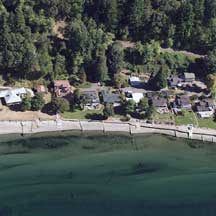Tidal influence as an ecological function
What are tidal influences?

What affects tidal processes?
Generally, tides operate at a regional scale and are not controllable at the local level. However, some large scale changes to river hydrology (e.g. diverting the White and the Cedar Rivers away from the Duwamish River) have allowed marine water to reach further up the river because of low fresh water flows.
Further, tidal height can be affected by changes in the sea level over the long term by tectonic subsidence and global warming and over the short term by storm surges and El Nino events.
Tidal influences can be interrupted or lost through changes in beach elevations by shoreline armoring and by artificial tidal restrictions at stream outlets (e.g. culverts, tide gates, and weirs) and along marine shorelines. Shoreline armoring at or below ordinary high water levels physically changes the location where tidal waters have influence, forcing the tidal influence offshore.
The interruption of the tidal influences can prevent the growth of marine vegetation and degrade spawning habitat in estuaries. Tide gates and weirs stop tidal waters from influencing streams and floodplains, either via salinity changes or through backwatering.
Known changes in local tidal influences:
- Roughly two-thirds of the Duwamish flow has been diverted, leading to tidal influences with fewer seasonal changes now than in the past.
- Many of the smaller streams entering Puget Sound have also had their flow regimes altered either through diversions of freshwater for human consumption or through increased levels of impervious surfaces in the basin.
- Rabb's Lagoon on Vashon Island historically had a sand spit at the outlet which allowed free exchange of freshwater and saltwater. Currently, Rabb's lagoon has a failing weir and a bulkhead across the mouth of the lagoon. These structures, cause freshwater to back up like a lake during low tides, while simultaneously reducing the duration that salt water has access to the lagoon during high tides. Thus, the tidal movement within the lagoon has been altered.
References: Williams et al 2003 and Williams et al 2004 (Acrobat pdf files).

 Translate
Translate